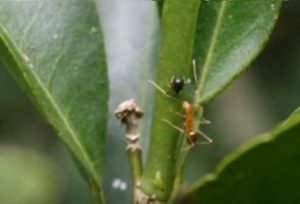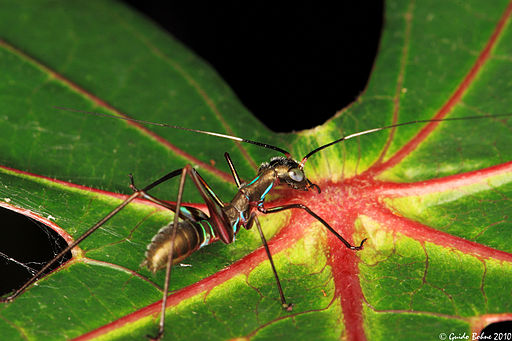*
Supercolonizing ant with fascinating behavior destroys ecological balance.

“Yellow crazy ant,” the common name of the species Anoplolepis gracilipes–seems a whimsical name for this beautifully colored ant with long legs and long antlers.
A yellow crazy ant, in typical ant behavior, tends one of a herd of plant parasites, an aphid on a leaf, to harvest, or milk, the aphid of it’s sweet secretions, seemingly a pastoral marvel of insect behavior.
But as a highly successful invasive species and predator, the yellow crazy ant is anything but whimsical or pastoral. As colonies, yellow crazy ants devastate native plant and animal species in areas that have developed unique habitats over millenia. Commercially, they make farming difficult. Viewed by scientists and environmentalists, they are an amazing and intriguing species of ant, but their destructive power cannot be ignored.
Sadly, they have invaded many areas where unique and endemic flora and fauna have become threatened by their presence. On Christmas Island, a territory of Australia in the Indian Ocean, near the Indonesian island of Java, the red crabs and small animals are systematically attacked and decimated by these ants. In 2003, the efforts to control the yellow ant ant population on Christmas Island was described as not entirely successful, by Columbia.edu:
Pesticide laden bait methods have been deployed on Christmas Island. Extensive mapping of infestations is critical so that baits are ideally placed. Low levels of pesticide are used to insure that it can be dispersed in the colony among other workers and queens. This method has not managed to rid Christmas Island of the species entirely. Higher success occurred in one area of Hawaii where an infestation was identified in an isolated location and eliminated with no population comeback thus so far.
The Wet Tropics Heritage Site of Queensland, Australia, known to Australians as the Australian “far north,” is experiencing an invasion that is not only alarming sugar farmers, but more importantly, upsetting the delicate balance in one of the world’s most unique habitats, to the extent that eradication of the yellow crazy ants has become a topic of national attention.
What is at stake in the Wet Tropics Heritage Site is a locality which, according to Wikipedia, is only rivaled by the islands of New Caledonia and Madagascar in uniqueness:
The tropical forests have the highest concentration of primitive flowering plant families in the world.[4] Only Madagascar and New Caledonia, due to their historical isolation, have humid, tropical regions with a comparable level of endemism.[2]
Source: Wikipedia
Featured image: By John Tann from Sydney, Australia (Yellow crazy ant) via Wikimedia Commons
Aphid farming image: Wikimedia commons
Visit the next page to view a video demonstrating how yellow crazy ants earned their common name.



